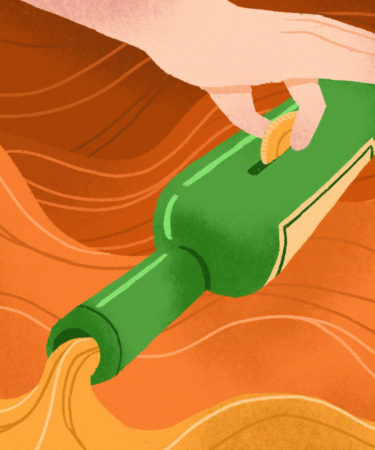“If you drive a car, I’ll tax the street. If you take a walk, I’ll tax your feet.”
The Beatles might have opted not to include a line or two about distillation in the 1966 tongue-in-cheek classic “Taxman,” but make no mistake about it: For about as long as industrial distillers have produced whiskey, governments have had a hand in their pockets.
We need only look back to 18th-century Ireland as a fine example. Booze was big business, then as now. The British government ruling Ireland at the time was strapped for cash thanks to the many wars it was engaged in. (No fewer than nine throughout the 1700s, in countries including Spain, France, Austria, and America.) Taxing alcohol had the dual intentions of raising money (successful) and curbing rampant overindulgence (not so much); by the latter half of the century, Irish distillers found themselves paying duty on everything from the amount of spirit they produced to the internal capacity of their stills. A third and final tax on the ingredients used to make whiskey, the 1785 Malt Tax, would prove to be a catalyst in shaping both the future and very identity of Irish whiskey.
Typical descriptions of Irish whiskey tend to include a few basic technical terms and descriptors: smooth profile, triple distillation, blends. It is by no coincidence that all of these factors describe Jameson, the category-defining brand that has dominated Irish whiskey sales for decades. Triple distillation and blending are not unique to Ireland. Yet, just as America has bourbon, and Scotch can only be produced across the Irish Sea in Scotland, Ireland is home to its own geographically protected, unique style of whiskey: Pot Still Irish Whiskey.
What sets pot still apart, somewhat counterintuitively, is not the vessel used for distillation but the ingredients used in the mash bill. Irish government regulations stipulate that, besides being produced in a pot still, the whiskey must be distilled from a mash containing a minimum of 30 percent malted barley and 30 percent unmalted barley, with other unmalted cereals also allowed. It is the unmalted grains and cereals that tie everything back to the 1785 tax. But first, a quick primer on malting, because it helps explain why it all matters.
In his book “A Glass Apart: Irish Single Pot Still Whiskey,” Fionnán O’Connor notes that “malt is essentially barley that has been tricked into prematurely sprouting into an actual plant.” To achieve this trickery, malt houses steep barley in water, then spread the grains out over a stone floor to germinate. During this process, special enzymes break down the barriers to the barley’s starch, then break that starch down to sugar, O’Connor explains. The process is vital because sugar is a necessary ingredient in the alcohol-producing fermentation. Once the sprouting rootlets have reached a certain length, they are roasted in iron-oven kilns to halt the germination process, at which point they are ready for the first stages of whiskey production.
This isn’t to say that unmalted barley provides nothing during fermentation, though. “You get much lower yields when working with unmalted,” explains Tim Herlihy, an Irish whiskey expert, author, and former Tullamore DEW brand ambassador. But more than sugar for alcohol production, unmalted barley’s biggest contribution is flavor and texture, he says. “There’s more spice, more pepperiness, and there’s a mouthfeel to it as well.”
So now back to 1785 and its impact on the modern-day definition of pot still whiskey. Faced with a new tax on malted barley, distillers included a proportion of raw, unmalted barley and other cereals in their mash bills to lower the duty they paid. Many accounts of the malt tax consider it as the lightbulb moment for Irish whiskey. An article on the Irish Whiskey Trail website paints it as the precise point at which “crafty” distillers invented a workaround of a foreign tax. “What was initially a means of cutting costs later turned into a fortuitous accident,” the article notes. It’s a nice notion but as with most things historical, it wasn’t quite so straightforward.
“By the time it was finally passed in 1785, the potential of unmalted grains seems to have already been common knowledge,” O’Connor notes. “Nine years before the Irish tax was even levied, the economist Adam Smith wrote that, ‘In what one called malt spirits, it makes up but a third part of the materials; the other two being raw barley or one third barley and one third wheat.’”
O’Connor also points out that one of the stipulations of the original 1785 malt tax was that distillers could not use mixed mashes of malted and unmalted grains. He writes, “Although this early provision was essentially ignored, the fact that the practice was prohibited means that it must have been in use before the tax.”
Even though the malt tax might not be the lightbulb moment for Irish whiskey many thought it was, there’s no doubt about it being the catalyst for the pot still style. After its introduction, the inclusion of malted and unmalted grains in mash bills was widely embraced by distillers across the country. By 1828, government records show that pot still whiskey accounted for 98.54 percent of the nation’s output.
Over time, and owing to a multitude of factors, distillers eventually turned their attention to blended whiskey. But even blends are not without influence from pot still. Distillers typically run the spirit through their stills three times to remove some of the harsher flavor compounds that arise from using unmalted barley, and the blends themselves often contain a mix of column-distilled grain whiskey and pot still whiskey (Jameson is one such example).
For now, blended whiskeys remain Ireland’s most popular by a long shot. But there’s no denying pot still’s position as the only style of whiskey unique to Ireland. “I would go as far as saying it is the most important part of Irish whiskeys DNA,” Herlihy says.
